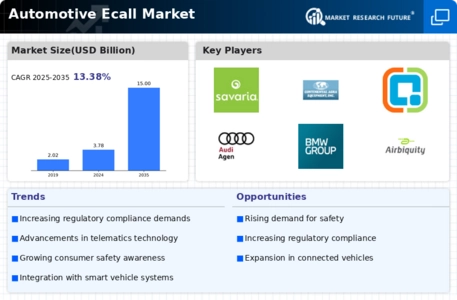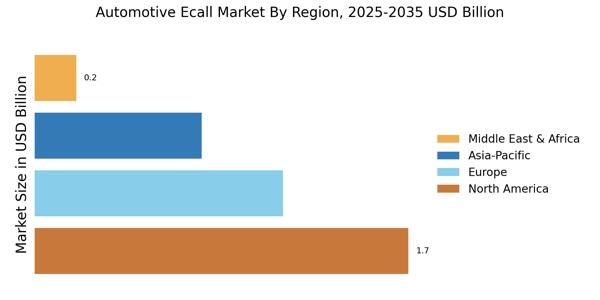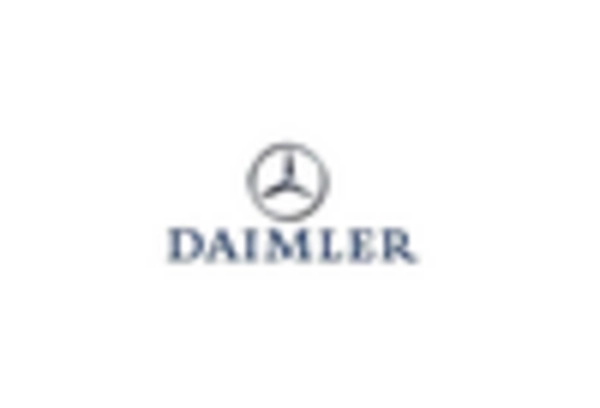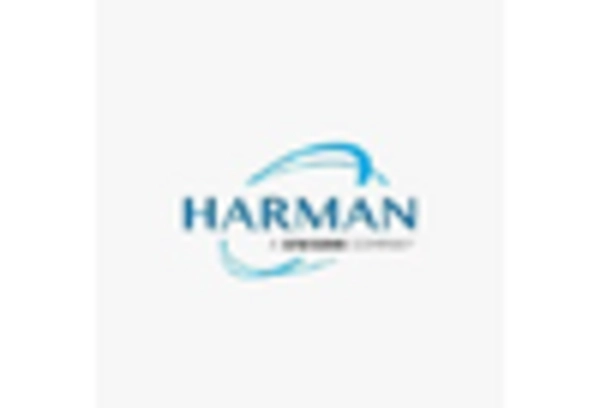Regulatory Compliance and Safety Standards
The Automotive Ecall Market is significantly influenced by stringent regulatory compliance and safety standards imposed by various governmental bodies. These regulations mandate the integration of emergency call systems in vehicles, ensuring that manufacturers adhere to safety protocols. For instance, the European Union has established regulations that require all new vehicles to be equipped with eCall systems by 2018, which has led to a marked increase in the adoption of these technologies. This regulatory push not only enhances vehicle safety but also drives market growth as manufacturers strive to meet compliance requirements. As a result, the Automotive Ecall Market is expected to witness a steady rise in demand, with projections indicating a compound annual growth rate of over 10% in the coming years.
Technological Innovations in Communication
Technological advancements in communication systems are propelling the Automotive Ecall Market forward. The integration of 4G and 5G technologies into vehicles enhances the efficiency and reliability of eCall systems, allowing for faster and more accurate emergency responses. These innovations facilitate real-time data transmission, which is crucial during emergencies. Furthermore, the development of advanced telematics systems enables vehicles to communicate with emergency services seamlessly. As a result, the Automotive Ecall Market is experiencing a surge in demand for vehicles equipped with these advanced communication technologies. Market analysts suggest that the increasing adoption of connected car technologies will further bolster the growth of the eCall market, potentially leading to a market valuation exceeding USD 10 billion by 2027.
Growing Focus on Connected Vehicle Ecosystems
The increasing emphasis on connected vehicle ecosystems is a pivotal driver for the Automotive Ecall Market. As vehicles become more interconnected, the integration of eCall systems within these ecosystems enhances their functionality and effectiveness. Connected vehicles can share critical data with emergency services, improving response times during accidents. This trend aligns with the broader movement towards smart transportation solutions, where vehicles communicate with each other and infrastructure. The Automotive Ecall Market is poised to benefit from this shift, as manufacturers invest in developing vehicles that are not only equipped with eCall systems but also integrated into larger connected networks. Analysts predict that this focus on connectivity will lead to a substantial increase in eCall system adoption, potentially doubling the market size by 2030.
Consumer Awareness and Demand for Safety Features
Consumer awareness regarding vehicle safety features is a driving force in the Automotive Ecall Market. As individuals become more informed about the benefits of eCall systems, there is a growing demand for vehicles equipped with these safety technologies. Surveys indicate that a significant percentage of consumers prioritize safety features when purchasing a vehicle, with eCall systems being a key consideration. This heightened awareness is prompting manufacturers to incorporate eCall technologies into their offerings, thereby expanding the market. The Automotive Ecall Market is likely to benefit from this trend, as consumer preferences shift towards vehicles that provide enhanced safety and emergency response capabilities. Consequently, the market is projected to grow steadily, with an anticipated increase in eCall-equipped vehicles in the next few years.
Partnerships and Collaborations in the Automotive Sector
Strategic partnerships and collaborations among automotive manufacturers, technology providers, and emergency service organizations are shaping the Automotive Ecall Market. These alliances facilitate the development and implementation of advanced eCall systems, ensuring that vehicles are equipped with the latest technologies. For instance, collaborations between automakers and telecommunications companies enable the integration of robust communication networks into vehicles, enhancing the effectiveness of eCall systems. Such partnerships not only drive innovation but also expand market reach, as companies leverage each other's strengths. The Automotive Ecall Market is likely to see an increase in collaborative efforts, which could lead to the introduction of more sophisticated eCall solutions, ultimately benefiting consumers and emergency responders alike.


















Leave a Comment